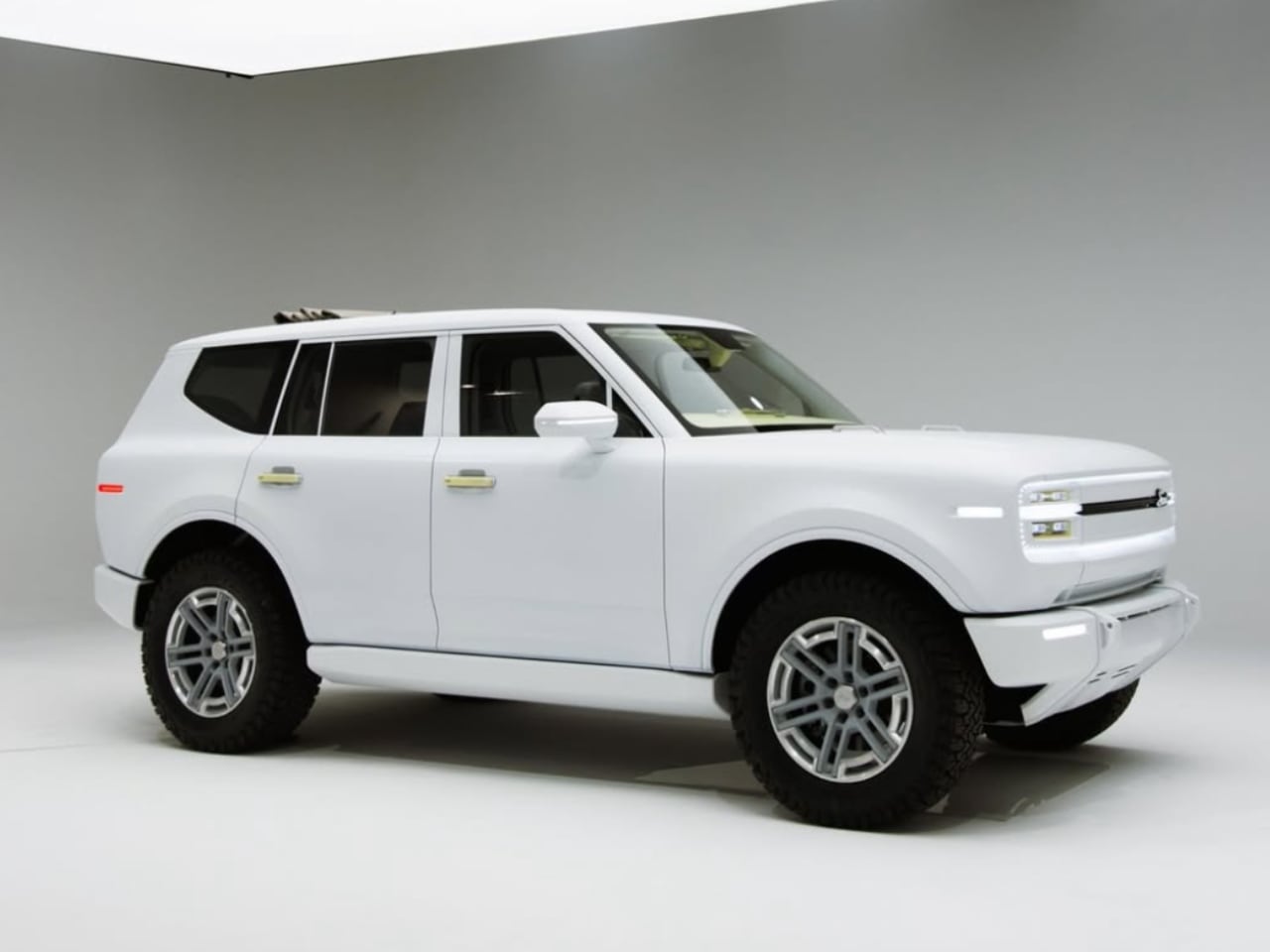The Scout Traveler doesn’t beg for your attention. In a landscape cluttered with electric SUVs desperately screaming, “look at me,” this vehicle whispers with quiet confidence. Its presence comes from architectural clarity and purposeful proportions, not from recycled nostalgia or tough-guy posturing. While competitors pile on swoopy lines and busy surfaces, the Traveler maintains a clean, disciplined form language that feels refreshingly honest.
Designer: Scout
Walk around this vehicle and you’ll notice something rare: visual consistency. The upright profile, substantial stance, and minimal overhangs create a silhouette that prioritizes actual functionality over styling tricks. Its volume exists to maximize interior space and mechanical capability, not to chase some wind-tunnel coefficient or lifestyle marketing angle.
Exterior: Honest Forms with Clear Purpose
Look closer at the front end. No aggressive “face” trying to intimidate other drivers. No fake intakes. No chrome jewelry. Instead, squared headlamps recede into clean housings, stacked horizontally without unnecessary flourishes. These lights sit wide, emphasizing the vehicle’s planted stance without the angry-eyebrow treatment that’s become an SUV cliché. Between them, a simple matte panel houses the Scout wordmark pressed directly into the surface. No illumination, no chrome, no fuss. Just clean identification that respects your intelligence.
The body surfaces tell a similar story of restraint. The hood meets the fenders without artificial tension lines. The shoulder maintains consistent visual weight from front to rear. Door cuts feature precise, uniform margins instead of sculpted edges pretending to be something they’re not. Side mirrors mount lower on the doors rather than up at the A-pillar, improving your actual forward visibility instead of chasing some styling trend. Door handles sit flush but remain visibly mechanical, not trying to hide as decorative elements.
Even the wheel arches show unusual discipline. In an era when every crossover gets swollen fenders to fake ruggedness, these openings maintain squared geometry with minimal lips. The tires themselves look properly sized for actual off-road use without the cartoonish proportions that plague so many “adventure-ready” vehicles. The whole stance communicates stability and capability without visual shouting.
The rear continues this functional honesty through a genuinely clever split tailgate. The upper glass lifts up while the lower panel folds down to create a stable platform. Try loading heavy gear in the rain sometime, and you’ll appreciate this thoughtful solution that keeps you dry while providing full access. The taillights echo the front design language with squared, recessed elements that integrate cleanly with surrounding surfaces. A removable flashlight tucked into the right taillight assembly shows that the designers actually considered real-world use cases instead of just styling exercises.
Roof options demonstrate similar thoughtfulness. Whether you choose the standard metal panel, panoramic glass, or the open-air Cabana setup, the structural perimeter stays visually consistent. There are no awkward transitions or compromised lines to accommodate different configurations. Each option simply plugs into the same clean framework, maintaining design integrity regardless of your preference.
Interior: Function Leading Form
Step inside, and the dashboard greets you with horizontal simplicity and logical organization. There are no stacked screens floating in space, no random decorative trim inserts, and no fake vents. The instrument panel stretches across with minimal level changes, providing a stable foundation for controls and displays. Physical switches, dials, and buttons occupy positions that make sense for how often you’ll use them, not arranged to create some abstract design statement. Digital displays integrate within this environment without dominating it, maintaining proper balance between physical and virtual interfaces.
Materials throughout the cabin prioritize tactile quality and durability over glossy first impressions. Fabric surfaces feature textural depth that will look good after years of use, not just on the showroom floor. Plastic components have honest grain patterns designed to hide wear rather than pretend to be something more expensive. The steering wheel keeps a classical circular shape without the flat-bottomed racing pretensions that have nothing to do with how you’ll actually drive this vehicle. Everything exists to work well rather than to impress your passengers on the first ride.
Seats focus on proper support for long drives rather than aggressive styling. The cushions and backrests provide even pressure distribution instead of exaggerated bolstering that looks sporty in photos but becomes uncomfortable after an hour on the road. Door panels incorporate practical storage, properly positioned armrests, and grab handles without decorative layering or fake material changes. Lighting concentrates on helping you see what you’re doing rather than creating a nightclub atmosphere. The designers skipped the trendy light strips and color-changing gimmicks, recognizing that illumination should primarily help visibility, not set a mood.
Design Philosophy: Substance Over Spectacle
The Scout Traveler represents something increasingly rare: a vehicle shaped by how people actually use things rather than by marketing narratives or styling trends. The design team has eliminated features that merely signal innovation without improving your experience. Instead, they’ve created a coherent visual language that extends through every detail you touch and see. This isn’t a vehicle screaming for Instagram likes or dealership drama. It builds lasting appeal through coherence, restraint, and clarity that will still feel right years after the payment book is finished.
The roof maintains a consistent horizontal plane. The beltline runs uninterrupted across the profile. Window openings feature deliberate rectangular proportions without the fashionable tapering that suggests motion at the expense of visibility and headroom.
This approach marks a refreshing departure from industry norms where visual gimmicks often trump usability and longevity. By focusing on functional geometry and material honesty, the Scout Traveler offers something genuinely different from vehicles designed primarily to trigger impulse purchases. The discipline evident throughout suggests designers who actually care about creating lasting value rather than chasing this season’s styling fads.
The post Scout Traveler SUV: Reviving a Legend Through Calculated Design Restraint first appeared on Yanko Design.

